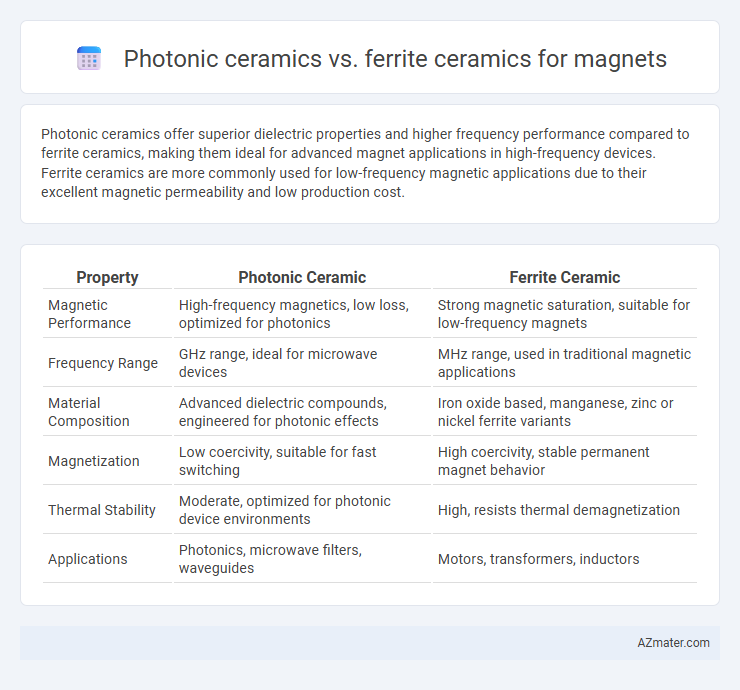Photonic ceramics offer superior dielectric properties and higher frequency performance compared to ferrite ceramics, making them ideal for advanced magnet applications in high-frequency devices. Ferrite ceramics are more commonly used for low-frequency magnetic applications due to their excellent magnetic permeability and low production cost.
Table of Comparison
| Property | Photonic Ceramic | Ferrite Ceramic |
|---|---|---|
| Magnetic Performance | High-frequency magnetics, low loss, optimized for photonics | Strong magnetic saturation, suitable for low-frequency magnets |
| Frequency Range | GHz range, ideal for microwave devices | MHz range, used in traditional magnetic applications |
| Material Composition | Advanced dielectric compounds, engineered for photonic effects | Iron oxide based, manganese, zinc or nickel ferrite variants |
| Magnetization | Low coercivity, suitable for fast switching | High coercivity, stable permanent magnet behavior |
| Thermal Stability | Moderate, optimized for photonic device environments | High, resists thermal demagnetization |
| Applications | Photonics, microwave filters, waveguides | Motors, transformers, inductors |
Introduction to Photonic and Ferrite Ceramics in Magnetics
Photonic ceramics exhibit superior electromagnetic wave manipulation capabilities due to their engineered dielectric properties, making them ideal for advanced magnetics applications involving high-frequency signal processing. Ferrite ceramics, composed primarily of iron oxides with magnetic ions, are widely used in inductors, transformers, and microwave devices due to their high magnetic permeability and low electrical conductivity, which minimize eddy current losses. Both materials play critical roles in magnetics, with photonic ceramics enabling enhanced control of electromagnetic waves and ferrite ceramics providing efficient magnetic response and thermal stability.
Material Composition: Photonic vs. Ferrite Ceramics
Photonic ceramics primarily consist of engineered dielectric materials like barium titanate or titanates, designed for high-frequency optical and electromagnetic applications, whereas ferrite ceramics are composed of iron oxide combined with metals such as zinc, nickel, or manganese, optimized for magnetic properties. The material composition in photonic ceramics enables superior electromagnetic wave propagation and minimal loss, contrasting with the ferrite ceramics' composition that facilitates strong magnetic permeability and low electrical conductivity. This fundamental difference in material makeup dictates their respective performance in magnetics and photonic devices, with photonic ceramics excelling in dielectric resonators and ferrite ceramics dominating in magnetic cores and inductors.
Magnetic Properties Comparison
Photonic ceramics typically exhibit higher magnetic permeability and lower dielectric loss compared to ferrite ceramics, making them suitable for high-frequency applications. Ferrite ceramics offer superior magnetic saturation and thermal stability, which are crucial for power transformers and inductors. The choice between photonic and ferrite ceramics depends on the required balance of magnetic properties, such as coercivity, permeability, and temperature performance.
Dielectric and Photonic Behavior
Photonic ceramics exhibit superior dielectric properties compared to ferrite ceramics, with higher permittivity and lower loss tangent, enabling efficient manipulation of electromagnetic waves in photonic applications. Ferrite ceramics primarily demonstrate magnetic permeability and frequency-dependent dielectric responses ideal for microwave absorption and magnetic resonance but with limited photonic bandgap capabilities. The intrinsic photonic behavior in photonic ceramics facilitates tunable refractive indices and enhanced light-matter interaction, crucial for integrated photonic devices and sensors.
Manufacturing Processes and Techniques
Photonic ceramics for magnets employ advanced sintering techniques like spark plasma sintering and hot isostatic pressing to achieve high density and uniform microstructures, enhancing magnetic properties. Ferrite ceramics typically use conventional ceramic processing methods such as solid-state reaction and tape casting, focusing on scalability and cost efficiency for mass production. Control over grain size and phase purity during photonic ceramic fabrication enables superior magnetic performance compared to the more standardized and cost-effective ferrite ceramic manufacturing processes.
Performance in Magnetic Applications
Photonic ceramics exhibit superior magnetic permeability and lower eddy current losses compared to ferrite ceramics, making them ideal for high-frequency magnetic applications. Their enhanced thermal stability and reduced dielectric losses contribute to improved performance in high-power devices and communication systems. Ferrite ceramics, while cost-effective and widely used, typically demonstrate lower saturation magnetization and higher magnetic losses at elevated frequencies.
Thermal Stability and Durability
Photonic ceramics exhibit exceptional thermal stability withstanding high temperatures up to 1200degC without significant magnetic property degradation, making them ideal for high-temperature magnet applications. Ferrite ceramics, while cost-effective and corrosion-resistant, have lower thermal stability, typically operating effectively below 250degC before magnetic performance declines. Photonic ceramics also offer superior durability under cyclic thermal stress, maintaining structural integrity and magnetic efficiency better than ferrite ceramics in demanding environments.
Cost-Effectiveness Analysis
Photonic ceramics generally offer higher frequency performance and better temperature stability compared to ferrite ceramics, which makes them ideal for advanced microwave and RF applications despite their higher raw material costs. Ferrite ceramics, widely produced with established manufacturing processes, provide a cost-effective solution in bulk for low to mid-frequency magnetic applications, balancing moderate performance with affordability. When conducting a cost-effectiveness analysis, the choice often hinges on the application's frequency requirements and production volume, with ferrite ceramics favored for large-scale, budget-conscious projects and photonic ceramics preferred where superior performance justifies the elevated price.
Environmental Impact and Sustainability
Photonic ceramics have a lower environmental impact compared to ferrite ceramics due to their energy-efficient manufacturing processes and the use of less harmful raw materials, reducing toxic waste and emissions. Ferrite ceramics often rely on heavy metals like iron and barium, which pose challenges in mining and disposal, leading to greater environmental risks. Sustainable magnet production increasingly favors photonic ceramics for their recyclability and reduced carbon footprint throughout the lifecycle.
Future Trends in Magnetic Ceramic Materials
Photonic ceramic magnets are gaining traction due to their superior frequency response and low dielectric losses, making them ideal for next-generation high-frequency and microwave applications. Ferrite ceramics remain prevalent for cost-effective, robust, and stable magnetic performance in traditional power and electronic devices, but their relatively lower magnetic saturation limits advanced miniaturization. Future trends point toward hybrid composites combining photonic ceramics' tunable electromagnetic properties with ferrites' thermal stability to achieve multifunctional magnetic materials optimized for 5G, IoT, and electric vehicle technologies.

Infographic: Photonic ceramic vs Ferrite ceramic for Magnet
 azmater.com
azmater.com